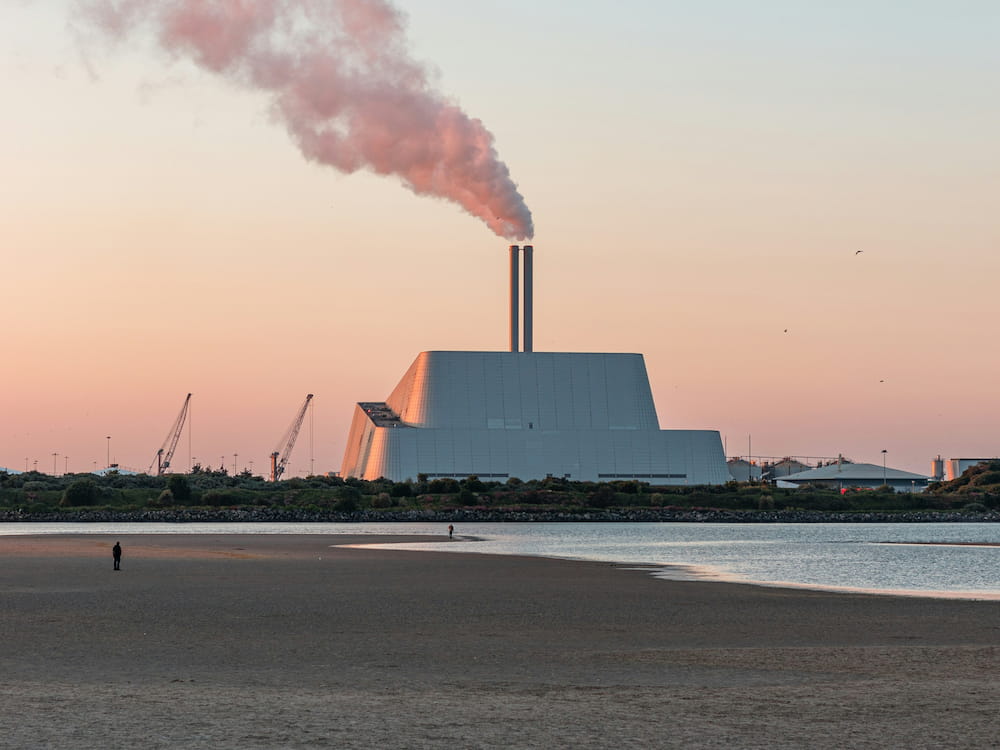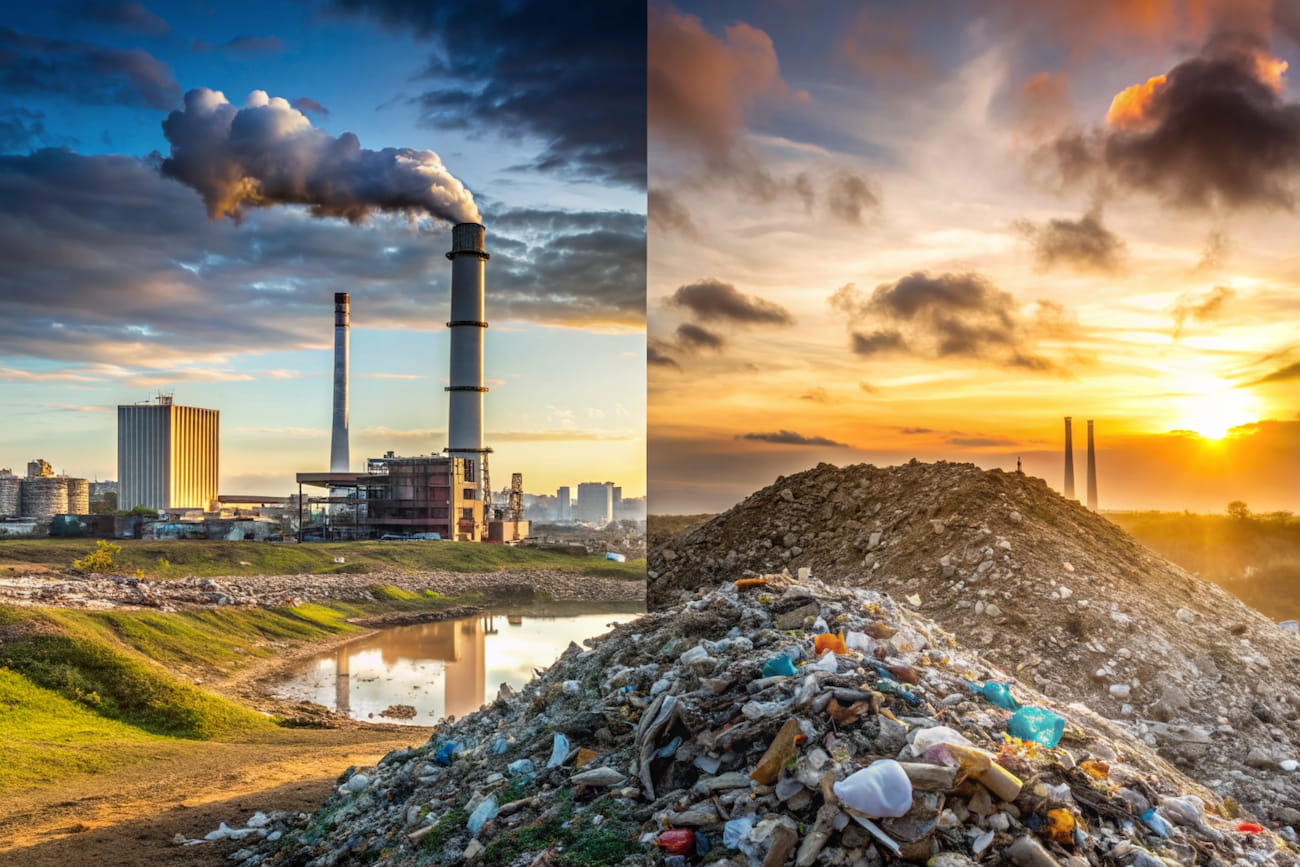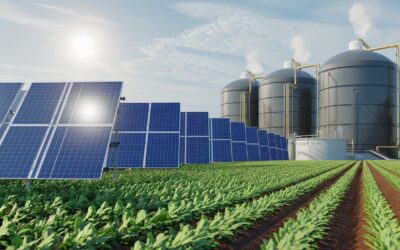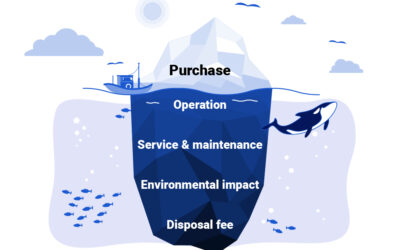The issue of pollution generated by waste management is of fundamental importance for the health of our planet.
In Italy, the choice between landfills and waste-to-energy plants is at the center of a heated debate.
This article explores the differences between these two waste disposal methods, highlighting how, contrary to what you might think, waste-to-energy plants can represent a more ecological solution than landfills.
Key points
- Landfills produce significant quantities of methane gas, a powerful greenhouse gas, making them much more impactful on the climate than waste-to-energy plants.
- Modern waste-to-energy plants have very stringent emission limits and use advanced technologies to reduce harmful emissions.
- In Italy, waste-to-energy plants are mainly concentrated in the North and Centre, highlighting an uneven geographical distribution.
- Public perception of waste-to-energy plants is often negative, but scientific data shows that their environmental impact is significantly lower than that of landfills.
- Waste-to-energy plants contribute to energy production, thus providing a double benefit: waste reduction and energy generation.
Environmental impact of landfills compared to waste-to-energy plants

The production of methane gas from landfills
Landfills represent a significant source of greenhouse gas emissions, particularly methane, a greenhouse gas approximately 25 times more potent than CO2 in the first 100 years. This gas is mainly formed from the decomposition of organic materials present in waste. Methane production from landfills contributes significantly to global warming , making landfills less sustainable than waste-to-energy plants.
Landfills not only emit methane gas, but also produce leachates that require purification treatments, further increasing the environmental impact.
Here are some key points related to methane production from landfills:
- The decomposition of organic materials releases methane.
- Methane is a greenhouse gas with a much greater impact than CO2.
- Landfills take up space for centuries, with long-term consequences for the environment.
The effects of methane on the climate
Methane, released in large quantities from landfills, has a significant impact on global warming . This greenhouse gas, in fact, is known to be much more powerful than CO2 in retaining heat in the atmosphere, thus contributing significantly to the greenhouse effect. Its ability to influence the climate has been confirmed by numerous scientific studies, which highlight how methane has 25 times more impact than the CO2 produced by combustion.
Inadequate waste management, particularly the excessive use of landfills, has been identified as a major source of anthropogenic methane emissions.
A comparison between methane emissions from landfills and those produced by waste-to-energy plants shows a significant gap. While landfills contribute substantially to the emissions of this gas, waste-to-energy plants, thanks to their advanced technologies, manage to limit its production and release into the environment.
Comparison of CO2 and methane emissions
After examining the environmental impact of landfills and waste-to-energy plants, it is essential to compare their CO2 and methane emissions. Landfills generate methane , a greenhouse gas about 25 times more potent than CO2 in the first 100 years. This makes landfills a significant source of climate pollution compared to waste-to-energy plants.
Thanks to their ability to convert waste into energy, waste-to-energy plants not only reduce greenhouse gas emissions but also contribute to the energy fed into the grid. This process replaces the energy that would otherwise come from more polluting plants, further reducing CO2 equivalent emissions.
Here is a table summarizing the key differences:
| Emission | Landfills | Waste-to-energy plants |
|---|---|---|
| Methane | High | Bass |
| CO2 | Half | Bass |
This comparison highlights how waste-to-energy plants offer a cleaner and more sustainable alternative to landfill, with a significantly lower impact on the environment.
Advantages of waste-to-energy plants in waste management

Energy efficiency and energy recovery
In the context of waste management, waste-to-energy plants represent an advanced solution for energy recovery. Thanks to the latest generation technology , these systems are able to transform waste into electrical and thermal energy with significantly higher efficiency than in the past. The ability to recover up to 85% of the heat produced by waste combustion is evidence of the positive evolution of these plants.
Another underestimated factor is waste transportation. The combination of savings due to the replacement of energy and raw materials and to having avoided the impacts linked to landfill disposal makes the balance of incineration with energy recovery negative.
However, it is important to consider that the overall energy balance must be evaluated in a broader context, which also includes recycling and the use of alternative energy sources. The main challenge remains that of integrating waste-to-energy plants into a waste management strategy that favors source reduction and recycling, without neglecting the energy recovery potential offered by these plants.
Strict limits on emissions
Waste-to-energy plants in Italy are subject to very stringent limits on emissions , imposed by both European and national regulations. These limits are among the lowest compared to all other industrial sectors, highlighting the commitment towards lower emissions of pollutants into the atmosphere.
Emission limits for waste-to-energy plants are set by Directive 2010/75/EU on industrial emissions, with Italy imposing even higher standards.
This commitment translates into emission values much lower than the maximum permitted, thus guaranteeing a significant reduction in environmental impact compared to landfills. The following table shows some of the pollutants monitored and their emission limits:
| Polluting | Emission limits (mg/m³) |
|---|---|
| Dust | <2-5 |
| HCI | <2-8 |
| HF | <15-40 |
| SO2 | 50-150 |
| NOX | <3-10 |
| CO | 10-500 |
These limits help keep air cleaner and protect public health, demonstrating that waste-to-energy plants can be a sustainable solution for waste management.
Reduction of environmental impact compared to landfills
When comparing landfills and waste-to-energy plants, a crucial aspect is the environmental impact. Thanks to advanced technologies and strict regulations, waste-to-energy plants significantly reduce the environmental impact compared to landfills. This is mainly due to the lower production of methane gas, a powerful greenhouse gas, and the reduction of leachates which require expensive and complex purification treatments.
Another underestimated factor is waste transportation. Quality separate waste collection and the creation of a widespread network of recovery and selection plants significantly reduce waste transport, further contributing to reducing environmental impact.
Here are some key advantages of waste-to-energy plants compared to landfills:
- Reduction of greenhouse gas emissions
- Less space occupation
- Decrease in leachate production
- Energy efficiency and energy recovery
These elements highlight how waste-to-energy plants represent a more sustainable and responsible solution in waste management, significantly contributing to the protection of the environment.
The geographical distribution of waste-to-energy plants in Italy

Concentration in the North and Center
The geographical distribution of waste-to-energy plants in Italy shows a marked concentration in the Northern and Central regions. This geographical imbalance poses significant challenges for achieving European recycling objectives, especially in the southern regions, where the need for new plants is most pressing. Separate waste collection, although a fundamental step towards sustainability, is not sufficient on its own to meet these objectives.
To achieve the 2035 objectives, it is necessary to start up another 2.7 million tonnes in waste-to-energy plants at a national level, with particular emphasis on the Central-Southern regions.
The lack of adequate infrastructure in Southern Italy not only slows down progress towards more sustainable waste management, but also entails significant additional costs for citizens, estimated at 40,000 tonnes of CO2 and 75 million euros more on the TARI, with 90 % of these costs borne by the inhabitants of the Centre-South.
The last waste-to-energy plant inaugurated
The inauguration of the latest waste-to-energy plant in Italy marks an important step towards more sustainable waste management. This plant represents the technological cutting edge in the sector, with a treatment capacity that aims to significantly reduce the environmental impact compared to traditional landfills.
Its implementation has been welcomed with interest from local authorities and the community, highlighting the importance of investing in advanced technologies for waste treatment.
The geographical distribution of waste-to-energy plants in Italy shows a prevalence in the North and Centre, with the latest inaugurated plant adding to this trend. Here is a brief overview:
- Northern Italy : greater concentration of waste-to-energy plants.
- Central Italy : significant presence, but lower than in the North.
- Southern Italy : fewer plants, highlighting a need for development in this area.
Implications for European recycling targets
The European Union has set ambitious goals for waste management by 2035, aiming for a recycling rate of 65% and limiting that sent to landfill to 10%. To achieve these goals, Italy faces a significant challenge , given its current waste disposal infrastructure.
The need to increase waste-to-energy capacity appears evident, especially in the Central-Southern regions, where at least five new plants would be needed.
The current geographical distribution of waste-to-energy plants shows a concentration in the North and Centre, leaving large areas of the country uncovered. This geographical imbalance further complicates the achievement of European objectives, making it imperative to have a development plan that includes the construction of new plants in the most lacking regions.
Public perception and scientific reality

The contrast between facade environmentalism and scientific data
In the public debate, a clear discrepancy is often observed between superficial environmentalism and scientific evidence. The gap between words and deeds is a significant obstacle in the fight against pollution and sustainable waste management. Many proclaim themselves defenders of the environment, but ignore or minimize the scientific data that highlights the effectiveness of waste-to-energy plants compared to landfills.
The responsibility to bridge this gap lies not only with environmentalists but also with institutions, which must base their decisions on solid scientific foundations.
Here are some of the main critical issues raised:
- Irresponsible use of vocabulary : terms such as “incinerator” and “waste-to-energy plant” are often confused, fueling prejudices and false beliefs.
- Obstruction by environmental committees : Opposition to new plants is often driven by ideological motivations rather than concrete environmental considerations.
- Political opportunism : politics exploits environmentalism as a vote-gathering tool, neglecting the real needs for sustainable waste management.
Clarity and honesty in public debate are essential to overcome these obstacles and to promote effective and sustainable solutions for waste management.
La Crusca on the distinction between incinerators and waste-to-energy plants
The Accademia della Crusca, in 2018, clarified the use of the terms incinerator and waste-to-energy plant, underlining that, although they are often used as synonyms, there is a substantial difference linked to energy recovery. The incinerator simply burns waste , producing ash and waste gases, while the waste-to-energy plant, in addition to destroying waste, recovers the heat produced to generate energy, such as steam or electricity.
The Crusca academy confirms: Waste-to-energy plants is a more specific word that underlines the value of the energy produced, distancing itself from the idea of environmental danger associated with incinerators.
This distinction is not only semantic but reflects a different approach towards environmental impact. While incinerators are considered obsolete and more polluting, waste-to-energy plants represent a more sustainable solution, capable of integrating into the circular economy thanks to energy production.
The modest impact of the latest generation waste-to-energy plants
The latest generation waste-to-energy plants represent a more sustainable solution than landfills, thanks to their ability to convert waste into energy. However, it cannot be ignored that combustion produces CO2 , contributing to the greenhouse effect, albeit to a lesser extent than landfills. This aspect underlines the importance of considering waste-to-energy plants as a short-term solution, waiting for even cleaner and more sustainable technologies.
The production of CO2 from waste-to-energy plants, although lower than that from landfills, remains a factor to consider in the fight against climate change.
Despite this, studies show that the environmental and human health impact of waste-to-energy plants is remarkably low, especially when compared to that of landfills. These plants are constantly monitored and epidemiological analyzes have not shown an increase in pathologies in the surrounding areas. Furthermore, the energy produced by waste-to-energy plants replaces other, more impactful forms of heat production, such as fossil fuels, thus contributing to an overall reduction in harmful emissions.
Advanced technologies in modern waste-to-energy plants

Effective filters and emissions reduction
Modern waste-to-energy plants are equipped with highly effective filters that play a crucial role in reducing harmful emissions. These advanced filtration systems are capable of treating and retaining a wide range of pollutants, including fine particles, acid gases, dioxins and heavy metals such as mercury. Their efficiency is made possible thanks to the use of cutting-edge technologies, which include electrostatic filters , acid gas absorbers and dust filters.
Filter technology in waste-to-energy plants has undergone considerable evolution, making them capable of capturing even the smallest particles and significantly improving air quality.
Here are some of the main pollutants treated by advanced filters in waste-to-energy plants:
- Fine particles (PM10 and PM2.5)
- Acid gases (such as SO2 and NOx)
- Dioxins
- Heavy metals (mercury, lead)
Continuous innovation in this sector not only improves energy efficiency and energy recovery but also contributes to keeping the environmental impact of waste-to-energy plants at minimum levels, confirming their key role in sustainable waste management.
Energy production and contribution to the grid
Modern waste-to-energy plants not only manage waste efficiently, but contribute significantly to the energy grid. The production of energy from these plants can replace that coming from more polluting sources , as highlighted by the comparison with the emissions that would occur if the same waste were sent to landfill. In fact, methane is generated in landfills, a greenhouse gas much more powerful than CO2.
The ability to produce thermal and electrical energy with waste-to-energy plants is a fundamental aspect in evaluating their environmental impact.
Virtuous examples of waste-to-energy plants that have integrated energy production and district heating systems include cities such as Brescia, Lecco and Bolzano. These plants demonstrate how it is possible to obtain a positive overall energy balance, contributing to the reduction of greenhouse gas emissions and the production of renewable energy.
- Avoided emissions : Replacement of energy from more polluting systems.
- Energy production : Inserted into the grid, replacing non-renewable sources.
- Environmental impact : Significant reduction compared to landfills.
The challenge remains that of balancing energy production with the need to minimize environmental impact, following community principles which place energy recovery after the reduction, reuse and recycling of waste.
Comparison with landfill emissions
In the comparison between waste-to-energy plants and landfills, it clearly emerges that the environmental impact of the latter is significantly higher. Landfills emit almost double the CO2 equivalent compared to waste-to-energy plants for the same quantity of waste treated. This data is crucial to understand the superiority of waste-to-energy plants in terms of emissions.
Thanks to their energy recovery capacity, waste-to-energy plants not only reduce the volume of waste, but transform a significant part of it into energy, thus contributing to a more sustainable energy balance.
Here is a summary table of the average emissions per ton of waste treated:
| Disposal system | CO2 equivalent (kg/tonne) |
|---|---|
| Landfills | 1.400 |
| Waste-to-energy plants | 800 |
These data highlight how waste-to-energy plants are a more ecological and sustainable solution than landfills, especially considering the credits for emissions avoided thanks to energy recovery. The reduction of greenhouse gas emissions is a fundamental benefit in combating global warming and climate change.
Conclusion
In conclusion, the in-depth analysis of the scientific evidence and available data demonstrates unequivocally that landfills represent a significantly greater environmental threat than waste-to-energy plants.
Although combustion in waste-to-energy plants produces CO2, their impact on climate change is significantly lower than that of landfills, which emit larger quantities of methane gas, a powerful greenhouse gas.
Furthermore, landfills take up space for centuries and produce harmful leachates, while waste-to-energy plants, thanks to advanced technologies, have very stringent limits on emissions and effectively contribute to reducing the carbon footprint.
It is therefore essential to reconsider waste management by favoring solutions which, such as waste-to-energy plants, offer a more favorable environmental balance and represent a step forward towards sustainability.
Frequent questions
Do waste-to-energy plants pollute more than landfills?
No, scientific studies show that landfills have an environmental impact eight times higher than waste-to-energy plants, mainly due to the production of methane gas, which is much more climate-altering than the CO2 produced by combustion in waste-to-energy plants.
How many waste-to-energy plants are there in Italy?
In Italy there are 37 waste-to-energy plants, most of which are located in the North and Centre.
Is methane more harmful than CO2?
Yes, methane gas, produced by the fermentation of the organic component of landfill waste, has 25 times more impact on the climate than the CO2 produced by combustion in waste-to-energy plants.
What is the latest waste-to-energy plant inaugurated in Italy?
The article does not specify the name of the latest waste-to-energy plant inaugurated, but underlines that the majority of the 37 Italian waste-to-energy plants are located in the North and Centre.
Do waste-to-energy plants contribute significantly to PM10 emissions?
No, PM10 (fine particulate matter) emissions from waste-to-energy plants are extremely low, equal to 0.03% of total emissions, thanks to very stringent limits on emissions and the use of advanced filtration technologies.
What is the difference between incinerators and waste-to-energy plants?
The main difference between incinerators and waste-to-energy plants lies in the approach to waste treatment: while incinerators simply burn waste, waste-to-energy plants recover energy from the combustion process, thus contributing to the production of energy in a less polluting way.
Meta Description
Find out how waste-to-energy plants reduce environmental impact compared to landfills, with energy advantages and lower emissions.




